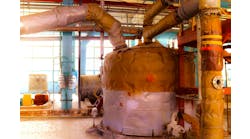New environmental performance data demonstrate that Qnergy’s PowerGen system is the first generator to enable 100% methane destruction. The Free Piston Stirling Engine (FPSE) demonstrates greater environmental performance, exceeding EPA guidelines, according to independent third-party testing.
The results conclusively show that, for the first time, environmentally friendly, utility-grade electrical power can be sourced from methane generation at the site, using a generator with zero methane slip. The proven system is already in use on more than 1,000 sites across the Americas, where it has delivered more than 15 million hours of reliable power, with a maintenance-free engine.
The data can be accessed here.
Qnergy’s PowerGen technology is based on an external combustion engine, with a clean-burning external combustor designed to work with any gaseous fuel. It uses power electronics and software to control variable raw source fuel feedstocks. Third-party researchers tested the performance of the PowerGen, finding that combustion resulted in >99.998% (~100%) methane destruction efficiency, with particulate matter, CO, and NOx emissions levels at 0.11, 0.30, and 1.1 g/kW.hr, respectively, that meet and exceed EPA emission criteria.
Methane is a potent greenhouse gas, with 84X the global warming potential of CO2 over its first 20 years when allowed to escape into the atmosphere. The productive use of methane waste is a global challenge, given the many distributed sources, from upstream well pads in the energy industry to farms and organic waste sites. These diverse methane sources all require power to capture, store, and/or convert methane into useful energy.
Historically, facilities that emit methane have been unable to use raw gas methane as a fuel, due to the challenges of corrosive contaminants, fluctuations in flow, and purity. Conventional generators based on internal combustion engines perform poorly, requiring regular maintenance and suffering ongoing corrosion and high operating costs. In addition, these conventional engines do not fully combust methane, leading to methane slip, or discharge to the atmosphere.
“Addressing and mitigating distributed methane sources is a key pillar in curbing climate change,” said Ory Zik, CEO of Qnergy. “The difficulty is that methane production is distributed across so many sites and that the ability to capture and prevent emissions at these sites requires power. Using the raw gas itself to generate utility-grade electricity for local use is an ideal solution, but only if the generator can be assured to emit near-zero methane missions.
“This research demonstrates how the capture and conversion of methane can be a perfect negative emissions source—turning a harmful greenhouse gas into ultra-low emission energy,” added Zik.
These results corroborate earlier third-party testing conducted by the Canadian Emissions Reduction Innovation Center (CanERIC), which also certified the PowerGen as the only generator tested to achieve 100% methane destruction.
A full whitepaper that explains the methodology and results is available here: https://qnergy.com/resource/qnergy-zero-methane-slip.
Qnergy was founded on a dual vision of converting otherwise wasted methane into useful energy and providing reliable power anywhere anytime. Its products turn waste methane into a source of clean, reliable electricity.











